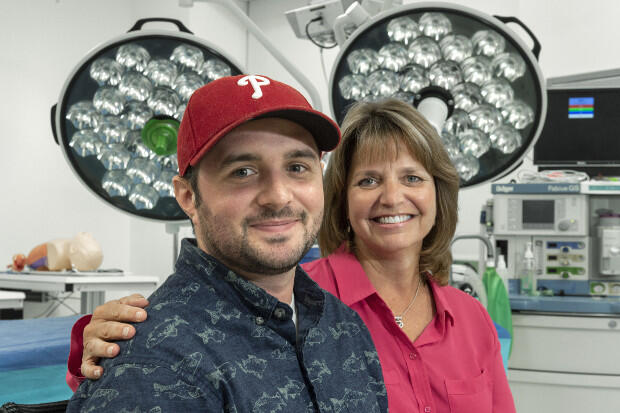
Jan. 25, 2019
Patient in need of kidney receives gift of life from a longtime friend
Stephen Robinson is one of the first patients to undergo robotically assisted kidney transplantation at VCU.
Share this story
After suffering renal failure due to a rare kidney disease, Stephen Robinson, a patient of the VCU Health Hume-Lee Transplant Center, now has a healthy start to the new year.
More than a year and a half ago, a visit to an eye doctor with complaints of poor vision and migraines led to the discovery of hemorrhaging behind Robinson’s eyes. After a trip to an emergency room near his Charles City County home, a kidney biopsy revealed that the previously healthy 28-year-old suffered from Berger’s disease, a condition that affects the kidneys’ ability to filter waste from blood.
Robinson required nightly dialysis to replace the toxin-removing function of his kidneys.
“My evenings revolved around treatment,” Robinson said. “I went to work in the morning, came home for dinner and got right back on the machine. It’s not fun when your stomach is continually bloated as you are repeatedly filled with fluids and drained.”
Six months after his diagnosis, Robinson was in stage four of the disease, and on the waiting list for a transplant at Hume-Lee. Several family members underwent testing for kidney donation but none was a match.
However, Terri Brown, 54, who has been friends with Robinson’s mother since childhood, was a match.
“I have two children of my own and if I were in that position I would hope that someone would step forward and help my kids,” she said. “His prognosis was not good without a transplant, and being 28 he has his whole life ahead of him.”
Saved by robotics
In July, Brown traveled to Richmond from her Delaware home for the transplant surgery. Robinson became the fourth patient at Hume-Lee to undergo a kidney transplant using the da Vinci Surgical System. Hume-Lee is one of the few centers in the United States to use the robotic method for kidney transplantation and is the largest organ transplant center in Virginia. To date, Hume-Lee has performed 12 robotic kidney transplants.
Chandra Bhati, M.D., associate professor of surgery at Virginia Commonwealth University School of Medicine, performed Robinson’s surgery. Bhati was the first on the East Coast to use the da Vinci System completely without any hand assistance for minimally invasive robotic kidney transplants.
The device gives surgeons the advantage of enhanced vision and mimics hand movement, Bhati said.
“The surgical vision under the robotic console is magnified and three-dimensional, so the vision you get is more precise and there is improved depth perception,” Bhati said.
I have two children of my own and if I were in that position I would hope that someone would step forward and help my kids. His prognosis was not good without a transplant, and being 28 he has his whole life ahead of him.
Robotic kidney transplants generally require smaller incisions and result in faster healing times. The procedure also can result in lower wound infection rates than traditional transplants, which makes it ideal for obese patients. In people whose body mass index is between 35 and 40, the wound infection rate with traditional kidney transplantation is 30 to 40 percent, national research has shown. This high risk of infection and other complications leads some transplant centers to recommend against kidney transplantation for very obese patients.
Following the procedure, kidney recipients are usually home in three to four days, with some patients requiring additional anti-rejection therapy. Donors are released in one to two days, Bhati said.
“We are providing the state of Virginia and surrounding states with a minimally invasive procedure that allows patients to get back to work and life sooner than would be allowed by a traditional open surgery,” Bhati said.
Within a month of the surgery, Robinson was back working full time, and had resumed his hobbies of fishing and kayaking.
“Every time I pull up my shirt for anyone to look at my incisions, they are surprised that I don’t have a big cut across my stomach, just two dots and a small slash on my belly button, that’s it,” Robinson said.
Gift of life
Last year, Hume-Lee performed 202 kidney transplants, with 38 from living donors like Brown. VCU has a 98 percent success rate for living kidney donation. Kidneys from living donors have the advantage of being implanted sooner than those from deceased donors, which contributes to a higher success rate.
Marlon Levy, M.D., Hume-Lee director, said living donors are vital for meeting the high need for kidneys and other organs. Currently, more than 100,000 people nationally are waiting for a kidney transplant.
“The need for donors is incessant. It’s a beast that can’t be fed enough,” Levy said. “There are huge advantages to live donation.”
Brown implores anyone eligible to consider kidney donation.
“It was a very easy decision and an easy process,” she said. “More people should be willing to do it because it is minimally invasive and recovery is very fast. You don’t need to be scared, and it’s a great way to help someone that is truly in need.”
Subscribe to VCU News
Subscribe to VCU News at newsletter.vcu.edu and receive a selection of stories, videos, photos, news clips and event listings in your inbox.













